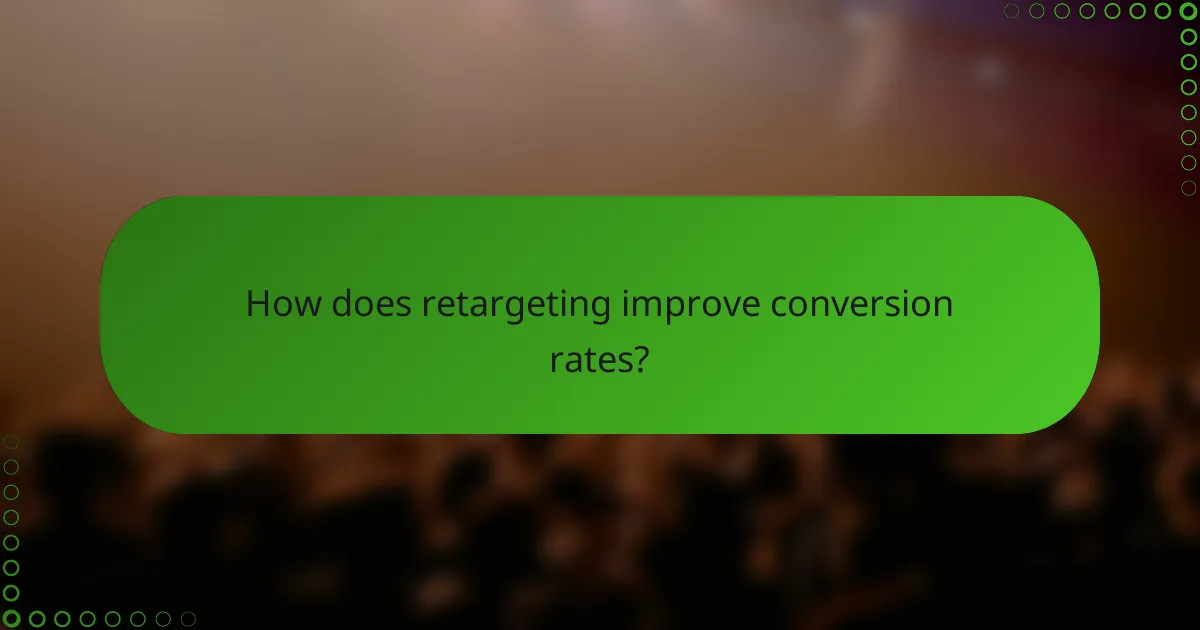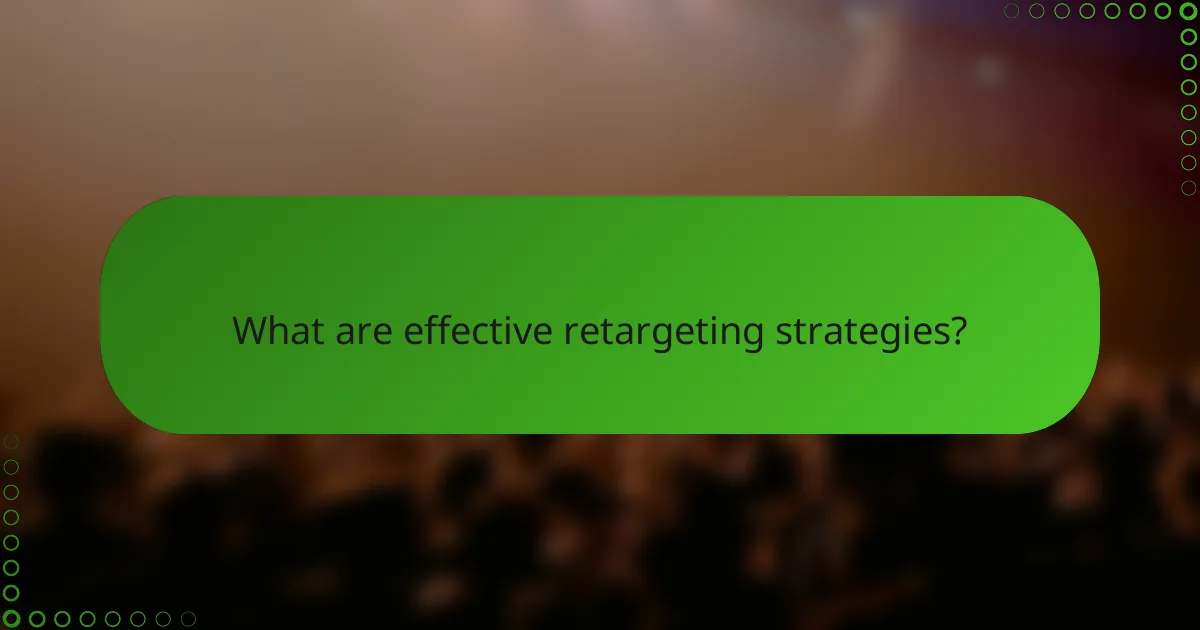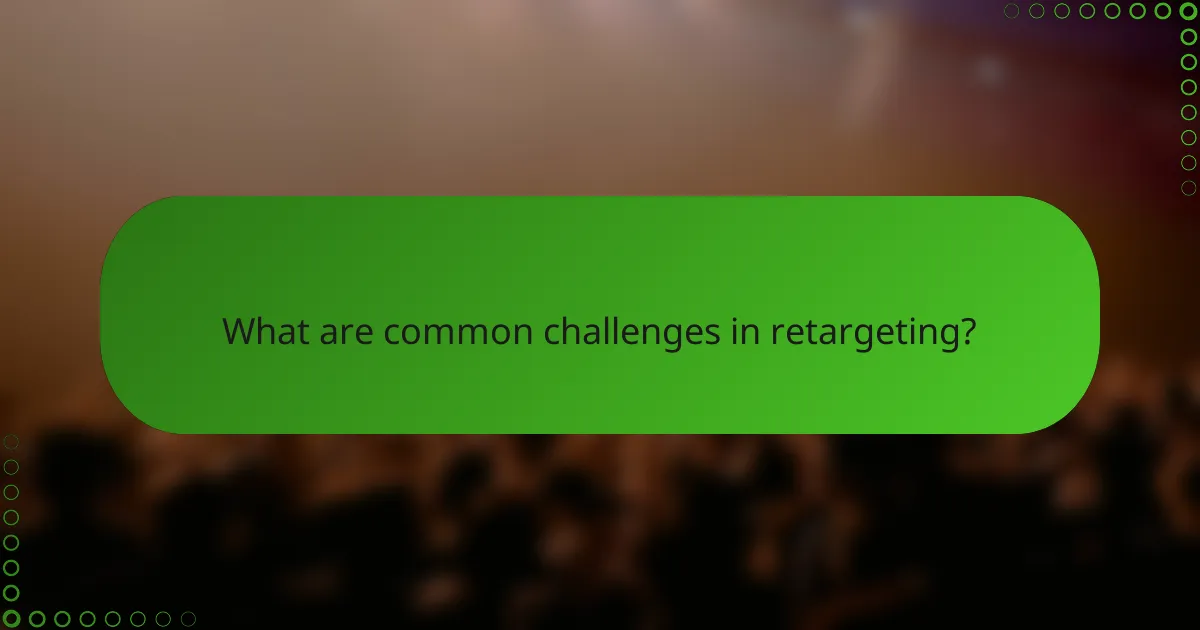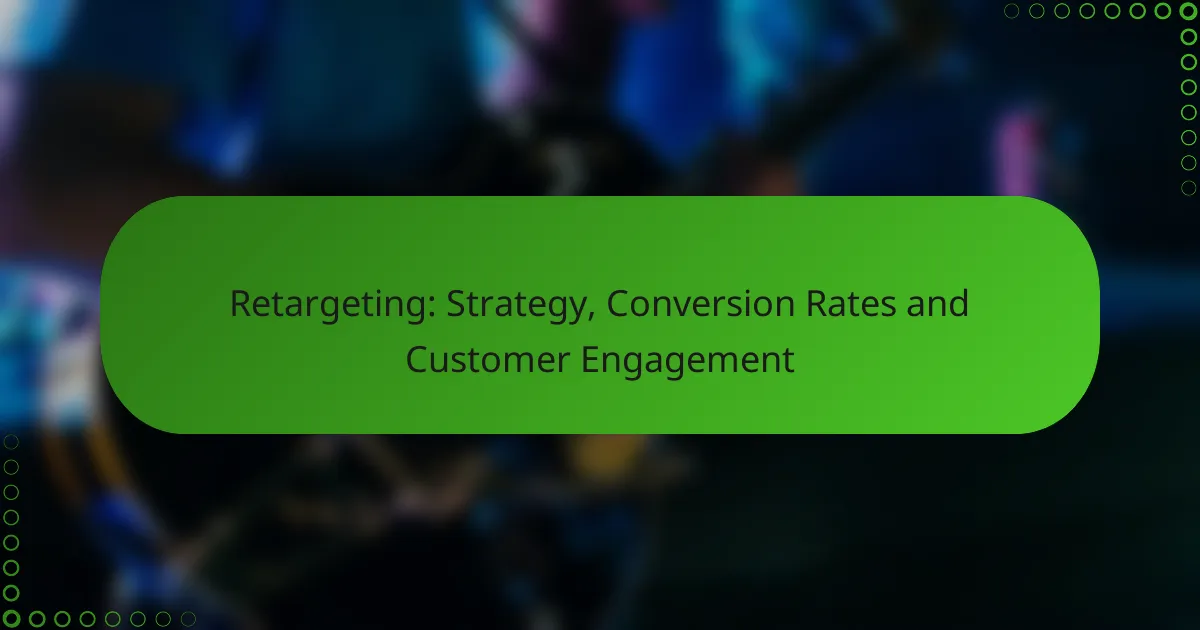Retargeting is a powerful marketing strategy that increases conversion rates by reminding potential customers of products they have previously shown interest in. By utilizing user behavior data, businesses can deliver targeted ads that resonate with specific audience segments, enhancing customer engagement and driving sales. Effective measurement of key metrics such as click-through rate and return on ad spend is essential for optimizing retargeting efforts and achieving better campaign performance.

How does retargeting improve conversion rates?
Retargeting enhances conversion rates by reminding potential customers of products they previously viewed, thereby increasing the likelihood of completing a purchase. This strategy leverages user behavior data to deliver targeted ads, making them more relevant and effective in driving sales.
Increased brand recall
Retargeting significantly boosts brand recall by consistently exposing users to your brand after their initial interaction. When users see your ads multiple times across different platforms, they are more likely to remember your brand when they are ready to make a purchase.
For example, a user who visits an online store but leaves without buying may see ads for that store on social media or other websites. This repeated exposure reinforces brand recognition and keeps your products top-of-mind.
Higher engagement through personalized ads
Personalized ads created through retargeting lead to higher engagement rates. By tailoring ads based on users’ previous interactions, you can present products that align with their interests, which increases the chances of clicks and conversions.
Consider using dynamic ads that showcase products users have viewed or similar items. This approach not only captures attention but also creates a sense of relevance, encouraging users to return and complete their purchases.
Targeting warm leads
Retargeting effectively targets warm leads—users who have already shown interest in your products. These individuals are more likely to convert compared to cold leads, as they are familiar with your brand and offerings.
To maximize this strategy, segment your audience based on their previous interactions. For instance, you might create different campaigns for users who added items to their cart but did not check out versus those who merely browsed. This allows for tailored messaging that addresses specific user behaviors, increasing the likelihood of conversion.

What are effective retargeting strategies?
Effective retargeting strategies focus on re-engaging users who have previously interacted with your brand but did not convert. By leveraging data on user behavior, businesses can create tailored ads that resonate with specific audience segments, ultimately improving conversion rates and customer engagement.
Segmenting audiences based on behavior
Segmenting audiences based on behavior involves categorizing users according to their interactions with your website or app. This can include actions like product views, cart abandonment, or previous purchases. By understanding these behaviors, you can tailor your retargeting efforts to address the specific needs and interests of each segment.
For example, users who abandoned their shopping carts may respond well to ads featuring discounts or reminders about the items they left behind. In contrast, users who have made a purchase might appreciate ads showcasing complementary products or loyalty rewards.
Dynamic product ads on Facebook
Dynamic product ads on Facebook automatically show relevant products to users based on their past interactions with your website. This strategy utilizes a product catalog linked to your Facebook account, allowing ads to display items that users have viewed or added to their carts.
To implement this, ensure your product catalog is up-to-date and optimized for Facebook’s specifications. Consider using eye-catching visuals and compelling copy to entice users back to your site. Testing different ad formats can also help determine what resonates best with your audience.
Utilizing Google Display Network
The Google Display Network (GDN) allows businesses to retarget users across millions of websites and apps. By displaying ads to users who have previously visited your site, you can maintain brand visibility and encourage conversions. GDN offers various targeting options, including contextual targeting and audience targeting based on user behavior.
To maximize effectiveness, create visually appealing ads that align with your brand and message. Regularly monitor performance metrics to refine your approach and ensure your ads reach the right audience at the right time. Consider setting frequency caps to avoid overwhelming users with too many ads.

What metrics measure retargeting success?
Key metrics for measuring retargeting success include click-through rate (CTR), return on ad spend (ROAS), and conversion rate optimization (CRO). These metrics help evaluate the effectiveness of retargeting campaigns and guide adjustments for better performance.
Click-through rate (CTR)
Click-through rate (CTR) indicates the percentage of users who click on your retargeting ads compared to the total number of impressions. A higher CTR suggests that your ads are resonating with the audience and prompting action. Aim for a CTR in the range of 0.5% to 2% for effective campaigns, depending on the industry.
To improve CTR, focus on creating compelling ad copy and eye-catching visuals. A/B testing different ad formats and messages can help identify what works best for your target audience.
Return on ad spend (ROAS)
Return on ad spend (ROAS) measures the revenue generated for every dollar spent on advertising. A ROAS of 4:1 or higher is often considered a good benchmark, meaning that for every dollar spent, four dollars in revenue are generated. This metric helps assess the financial effectiveness of your retargeting efforts.
To maximize ROAS, segment your audience based on behavior and tailor your ads accordingly. Consider adjusting bids and budgets based on the performance of different segments to optimize overall returns.
Conversion rate optimization (CRO)
Conversion rate optimization (CRO) focuses on increasing the percentage of users who complete a desired action after interacting with your retargeting ads. This could include making a purchase, signing up for a newsletter, or downloading a resource. Effective CRO can significantly enhance the overall success of your retargeting campaigns.
To enhance CRO, ensure that your landing pages are relevant and user-friendly. Use clear calls to action and minimize distractions to guide users toward conversion. Regularly analyze user behavior and make data-driven adjustments to improve the conversion process.

What are the prerequisites for a successful retargeting campaign?
Successful retargeting campaigns require effective tracking mechanisms and a well-organized customer database. These elements ensure that you can accurately target users who have previously interacted with your brand, maximizing the chances of conversion.
Setting up tracking pixels
Tracking pixels are essential for monitoring user behavior on your website. These small snippets of code allow you to collect data on visitors, such as pages viewed and actions taken, which is crucial for retargeting efforts.
To set up tracking pixels, choose a reliable advertising platform like Google Ads or Facebook Ads. Follow their guidelines to install the pixel code on your website, typically in the header section. Ensure that the pixel is firing correctly by using debugging tools provided by the platform.
Creating a customer database
A well-structured customer database is vital for effective retargeting. This database should include information about user interactions, preferences, and demographics, allowing for tailored marketing messages.
Start by collecting data through sign-up forms, purchase histories, and engagement metrics. Use Customer Relationship Management (CRM) software to organize this information. Regularly update the database to reflect new interactions and remove inactive users to maintain relevance in your campaigns.

How does retargeting affect customer engagement?
Retargeting significantly enhances customer engagement by reminding potential buyers of products they previously viewed or showed interest in. This strategy keeps brands top-of-mind, leading to increased interactions and conversions.
Increased interaction with ads
Retargeting campaigns often lead to higher interaction rates with ads compared to standard advertising methods. By displaying personalized ads to users who have already visited a website, brands can capture attention more effectively, resulting in click-through rates that can be several times higher than average.
For example, a user who browsed outdoor gear may start seeing ads for those specific products across various platforms. This tailored approach encourages users to revisit the site, increasing the likelihood of a purchase.
Enhanced customer loyalty
Retargeting not only drives immediate sales but also fosters long-term customer loyalty. By consistently engaging users with relevant ads, brands can create a sense of familiarity and trust, which is crucial for repeat business.
Moreover, retargeting can be used to promote loyalty programs or special offers, incentivizing customers to return. For instance, a brand might retarget users with a discount on their next purchase, reinforcing their connection with the brand and encouraging ongoing engagement.

What are common challenges in retargeting?
Retargeting can face several challenges that impact its effectiveness, including ad fatigue, audience segmentation, and privacy regulations. Advertisers must navigate these issues to optimize their campaigns and enhance customer engagement.
Ad Fatigue
Ad fatigue occurs when the same audience sees the same ads too frequently, leading to diminished returns. This can result in lower click-through rates and increased annoyance among potential customers. To combat ad fatigue, consider rotating ad creatives regularly and varying messaging to keep content fresh.
Audience Segmentation
Effective audience segmentation is crucial for successful retargeting. Without precise targeting, ads may reach users who are not interested in the product, wasting resources. Utilize data analytics to create distinct audience segments based on behavior, interests, and demographics, ensuring that the right message reaches the right people.
Privacy Regulations
Privacy regulations, such as GDPR in Europe and CCPA in California, impose restrictions on how user data can be collected and used for retargeting. Advertisers must ensure compliance with these laws to avoid penalties. Implement transparent data collection practices and provide users with clear options to opt-in or opt-out of retargeting campaigns.









